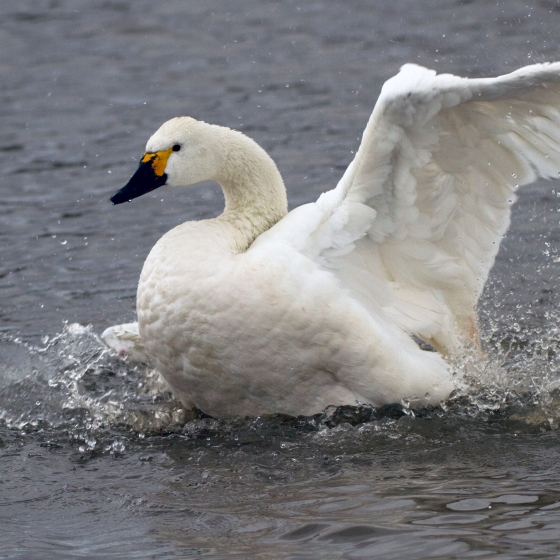Bewick's Swan

Introduction
Our smallest swan is a winter visitor from the Russian tundra. It has an elegant look with a rounded yellow patch on the bill.
Around one third of the world population of Bewick's Swans come to our inland wetlands for the winter, spread out mainly across southern England from the fenlands of East Anglia to the Severn Estuary. The Wetland Bird Survey reports a significant population decline over the last 25 years.
The Ouse and Nene Washes now hold the largest flocks, although the history of the species in England is tied to the Wildfowl and Wetlands Trust reserve at Slimbridge, where individual recognition based on the shape of the yellow bill patch has allowed the fate of families to be studied over many years.

Key Stats
Identification
ID Videos
This section features BTO training videos headlining this species, or featuring it as a potential confusion species.
Wild Swans
Songs and Calls
Call:
Flight call:
Status and Trends
Conservation Status
Population Size
Population Change
Historically, Bewick's Swans have been a regular winter visitor to the UK, primarily concentrated across southern England. Their wintering population was relatively stable from the mid-1980s until the mid-2010s when they began to exhibit a steep decline that is still continuing. During the last international census of the Northwest European Bewick's Swan population, carried out in 2020, no individuals were recorded in Scotland or Wales and the majority of the population was recorded at just a handful of sites in southern England: The Ouse Washes, Norfolk/Cambridgeshire, the Nene Washes, Cambridgeshire and Slimbridge on the Severn Estuary [WWT 2021]. Numbers in the UK have continued to fall since then.
Distribution
The species' winter distribution is patchy, with most flocks occurring in southeastern England, and very few in Ireland, Wales or Scotland. Despite a relatively large number of occupied squares, significant flocks are concentrated in the fenlands of eastern Britain, chiefly around the Ouse Washes and Nene Washes (WeBS Report 2011), with smaller concentrations in parts of the west, especially the Severn Estuary.
Occupied 10-km squares in UK
or view it on Bird Atlas Mapstore.
or view it on Bird Atlas Mapstore.
European Distribution Map
Distribution Change
Generally, there seems to have been an eastward shift in the wintering range of this population, as evidenced by the declines in Ireland and western Britain, which are on the western edge of the species' Palearctic range. This is possibly caused by birds 'short-stopping' in continental Europe.
Change in occupied 10-km squares in the UK
or view it on Bird Atlas Mapstore.
Seasonality
Bewick's Swans are winter visitors, though declining in abundance. They typically arrive in October and depart through March.
Weekly pattern of occurrence
The graph shows when the species is present in the UK, with taller bars indicating a higher likelihood of encountering the species in appropriate regions and habitats.

Movement
Britain & Ireland movement
Foreign locations of birds ringed or recovered in Britain & Ireland
Dots show the foreign destinations of birds ringed in Britain & Ireland, and the origins of birds ringed overseas that were subsequently recaptured, resighted or found dead in Britain & Ireland. Dot colours indicate the time of year that the species was present at the location.
- Winter (Nov-Feb)
- Spring (Mar-Apr)
- Summer (May-Jul)
- Autumn (Aug-Oct)

European movements
EuroBirdPortal uses birdwatcher's records, such as those logged in BirdTrack to map the flows of birds as they arrive and depart Europe. See maps for this species here.
The Eurasian-African Migration Atlas shows movements of individual birds ringed or recovered in Europe. See maps for this species here.
Biology
Productivity and Nesting
Nesting timing
Egg measurements
Clutch Size
Survival and Longevity
Survival is shown as the proportion of birds surviving from one year to the next and is derived from bird ringing data. It can also be used to estimate how long birds typically live.
View number ringed each year in the Online Ringing Report.
lifespan
Survival of adults
Survival of juveniles
Biometrics
Wing length and body weights are from live birds (source).
Wing length
Body weight
Ring Size
Classification, names and codes
Classification and Codes
- Order: Anseriformes
- Family: Anatidae
- Scientific name: Cygnus columbianus
- Authority: Ord, 1815
- BTO 2-letter code: BS
- BTO 5-letter code: BEWSW
- Euring code number: 1530
Alternate species names
- Catalan: cigne petit
- Czech: labut malá
- Danish: Pibesvane
- Dutch: Kleine Zwaan
- Estonian: väikeluik
- Finnish: pikkujoutsen
- French: Cygne siffleur
- Gaelic: Eala-bheag
- German: Zwergschwan
- Hungarian: kis hattyú
- Icelandic: Dvergsvanur
- Irish: Eala Bewick
- Italian: Cigno minore
- Latvian: mazais gulbis
- Lithuanian: mažoji gulbe
- Norwegian: Dvergsvane
- Polish: labedz czarnodzioby
- Portuguese: cisne-pequeno
- Slovak: labut malá
- Slovenian: mali labod
- Spanish: Cisne chico
- Swedish: mindre sångsvan
- Welsh: Alarch Bewick
Research
Causes of Change and Solutions
Causes of change
A detailed study into the behaviours of Bewick's Swans [Nuijten ei al. 2020a] based on resightings of marked birds found that they have decreased the distances that they migrate (short-stopping), both within their own lifetimes and at a generational level, meaning fewer are reaching the UK in winter (many are now overwintering in Germany instead). The study also identified a generational shift in the timing of arrival and departure from wintering gounds resulting in birds spending less time in their wintering areas (short-staying). Bewick's Swan numbers are also declining at a European scale and this decline has been linked to reduced productivity rates [Nuijten et al. 2020b].

